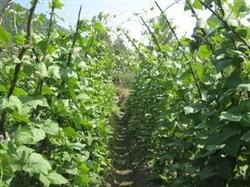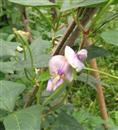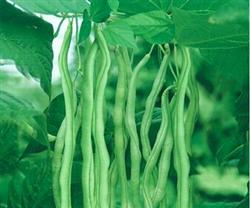How should kidney bean red root be solved?

Recently is the high incidence period of kidney bean red root, here for everyone to analyze the cause of legume red root in detail and introduce the prevention and treatment methods. First, symptom characteristics: from the point of view of the growth of the plant, the bottom leaves began to yellowing and thinning from the bottom to the top, and the growth potential of the plant was weak. If you pull out the kidney bean plant, you will find that the root system of kidney bean is red or shrivelled, and the root system has little or no new root. There are red striped disease spots on the main roots of some roots. The plant of kidney bean grows slowly, and the serious disease has a great influence on the pod setting of kidney bean, and the situation of falling flowers and pods occurs. Second, the cause of the disease: there are many reasons for the emergence of legume red root, mainly the following points. 1. Retting roots. Due to excessive watering, the soil moisture is too high, the permeability of water and air in the soil is poor, which is not conducive to the normal growth of the root system, and the root growth is poor, resulting in the underdevelopment of the root system, commonly known as "retting root". In serious cases, it leads to the peeling of the whole root system or the reduction of capillary roots. two。 Burn the roots. It is mainly divided into fertilizer and medicament-induced root burning. Due to excessive or unreasonable application of fertilizer, root burning occurs due to poor root growth, which is related to the lack of complete maturity of organic fertilizer in the base fertilizer. In addition, due to the application of fungicides to control red roots or nematodes too much or not spread evenly during planting, the plant will burn roots due to excessive dosage. 3. The planting is too dense. Because kidney beans are planted densely, some even plant 5-7 seeds in one hole, which is caused by nutritional competition between plants. in general, kidney bean plants are infected with germs first and then infected with red roots. 4. The ground temperature is too low. In the case of too low ground temperature, it can not guarantee the appropriate ground temperature needed for root growth, resulting in poor root growth, not easy to produce capillaries, and prone to root redness. 5. Root rot. In the case of excessive humidity, legume roots are easy to be infected by root rot bacteria, resulting in root diseases leading to red roots. 6. Anthrax. There are red roots in legume roots due to anthracnose infection, usually accompanied by red sunken spots on the stems above the ground surface, and red linear spots on the veins on the back of the leaves. There are red roots in kidney beans in the shed, how should they be solved? 1. Irrigate root. "Deep roots and luxuriant leaves". Only when the roots are good can the plants grow well. So the most important thing is to have a good root. It is recommended to irrigate the root every half to one month or so, choose one of the drugs such as methyl topiramate or carbendazim or bromofenitrile, and add rooting agent to irrigate the root, which can effectively reduce the death of trees. Pay attention to the large dosage, the adult stage can be irrigated with 42 to half a jin of water, it should be noted that the plants around the diseased plants should be irrigated continuously for 2 to 3 times, which can effectively control the development of the disease. two。 Water and fertilize. Watering should be done frequently with a small amount of water and a small amount of fertilizer for many times, among which the amount of chemical fertilizer should be reduced. It is suggested that the application of humic acid fertilizer or root-promoting fertilizer can ensure the normal growth of root system to the maximum extent, reduce the application amount of chemical fertilizer, avoid root injury or root burning, and appropriately reduce the poor root growth caused by low soil temperature. 3. Spray fertilizer on the leaves. Foliar spraying containing calcium magnesium iron and other trace elements foliar fertilizer can promote the normal growth of leaves and to a certain extent improve the resistance of plants to adverse environmental conditions. 4. Remove the diseased plant. The diseased plants should be pulled out in time, and quicklime can be sprinkled into the soil around the removed plants to disinfect the soil, kill germs and avoid large-scale infection of kidney bean Verticillium wilt. 5. The potion is applied to the hole. It is necessary to pay attention to the soil mixing treatment of the medicament, and generally carry on the mixing treatment according to the proportion of the medicament to the soil at 1:10, and pay attention to that the dosage should not be too large, which can reduce the drug damage caused by excessive or uneven application. 6. Appropriate sparse planting. It can reduce the kidney bean root competition caused by overplanting, avoid insufficient nutrition supply, and provide a suitable growth environment for the root system.
- Prev

Avoid watering kidney beans during flowering.
Some vegetable farmers planted kidney beans this year, because the soil was relatively dry because they had not been watered in the shed for more than 10 days, so in order to ensure the water supply of kidney beans, they were watered once during the flowering period of kidney beans, resulting in a large number of flowers and young pods just growing. This bothers farmers very much. So kidney bean flowering period when the soil is relatively dry, such as.
- Next

High-yield cultivation techniques of kidney bean
Kidney beans are native to Mexico and America, and have spread all over the world since the 17th century. They are also known as flowered kidney beans. Cultivation has a long history, due to the large export volume, the area is expanding year by year. It is nutritious, the protein content is high, namely the vegetable is the grain, but also can make the cake and the bean filling, is the export earns the foreign exchange.
Related
- The first cup of black tea in spring, the flavor and history of tea gardens in Kenya, Africa
- The computer can not only choose potatoes, but also grow tea rice. AI will grow winter oolong tea champion.
- It is not only the inflated tea bitten by insects, but also engraved with the four seasons tea in Beipu.
- The Oriental Beauty Tea Festival in Zhuxian County takes the stage at the weekend to experience the plus-size feast of oil tea.
- & quot; Oriental Beauty Tea & Exploration of Emei in Hsinchu, the hometown of quot;
- The new variety of strawberry "Tainong 1" dessert is the first choice with mellow aroma. Crimson gorgeous
- History of Tea in Taiwan: from Wild Inner Mountain to Export Tea Garden
- Two types of Taiwan Oriental Beauty Black Tea won the British three-Star Award for Childhood Tea Xiang Zhang Jiaqi changed from pilot to champion tea maker.
- Banana species and varieties: the planting history of Taiwan Xianren banana and dwarf banana is long, is banana disease resistant?
- Coffee planting Technology: Qianjie Coffee from Seedling to harvesting

